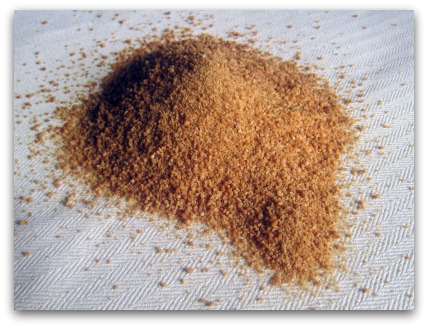Coconut Palm Sugar
- Coconut sugar (also known as coco sugar, coconut palm sugar or coco sap sugar) is a sugar produced from the sap of cut flower buds of the coconut palm. Coconut sugar has been used as a traditional sweetener for thousands of years in the South and South-East Asian regions where the coconut palm is in abundant supply. The world’s largest producers of coconuts are the Philippines and Indonesia.
- In some areas, predominantly in Thailand, the terms “coconut sugar” and “palm sugar” are often used interchangeably. However, coconut sugar is different both in taste, texture and manufacture methods from palm sugar, which is made from the sap in the stems of the Palmyra palm, the date palm, the sugar date palm, the sago palm or the sugar palm.
- Coconut sugar comes in crystal or granule form, block or liquid. It is essentially a two-step process. It starts with harvesting or “tapping” the blossoms of a coconut tree. Farmers make a cut on the spadix and the sap starts to flow from the cut. The sap is then collected in bamboo containers. The sap collected is then transferred into large woks and placed over moderate heat to evaporate the moisture content of the sap. The sap is translucent and is about 80% water. As the water evaporates, it starts to transform into a thick syrup-like substance known as a “toddy”. From this form, it is further reduced to crystal, block or soft paste form, or it remains in this form. Essentially, coconut sugar’s form depends on the moisture content of the toddy.
- Coconut sugar is subtly sweet almost like brown sugar but with a slight hint of caramel. However, since coconut sugar is not highly processed, the color, sweetness and flavor can vary depending on the coconut species used, season when it was harvested, where it was harvested and / or the way the “sap” or “toddy” was reduced.
Benefits
- Coconut sugar consists primarily of sucrose (containing glucose and fructose). “The major component of coconut sugar is sucrose (70–79%) followed by glucose and fructose (3–9%) each. Minor variations will occur, due to differences in primary processing, raw material source, tree age and variety of coconut.”
- The Glycemic Index of coconut sugar was reported by the Philippine Coconut Authority to be 35 and by that measure it is classified as a low glycemic index food. However, in that study the glucose standard was fed as an aqueous solution, while the sugar was fed as sugar. Making the test food slower and more difficult to absorb and digest relative to the test solution will lower its GI value. It is considered[by whom?] to be healthier than refined white sugar(60) and brown sugar(64).[citation needed] It can be used as a 1:1 sugar substitute for coffee, tea, baking, and cooking.
- Coconut sugar has a high mineral content, being a rich source of potassium, magnesium, zinc, and iron. In addition to this it contains Vitamin B1, B2, B3, and B6. When compared to brown sugar, coconut sugar has 18 times the potassium, 30 times the phosphorus and over 10 times the amount of zinc. The large amounts of K and P can be explained by the way coconut sugar is tapped from the inflorescences of the tree.
- The coconut sap, from which coconut sugar is derived, contains 16 amino acids. The amino acid which has the highest content in coconut sap is Glutamine.

